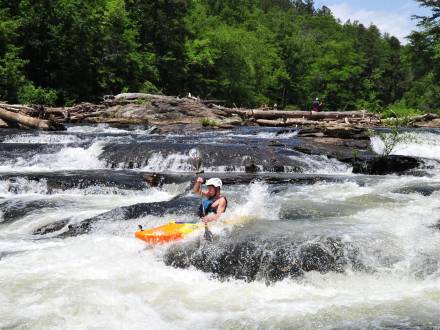Highway 9 Section
This attractive run can be broken into two parts by putting in/taking out at Castleberry Bridge near the town of Auraria.
The 6-mile section above Castleberry Bridge includes most of the significant whitewater on the Etowah. This section has wooded banks (which are giving way to residences) and several rock bluffs. The river has several Class I-II rapids and two rapids worthy of particular attention, Class II Chuck Shoals and Class IV Etowah Falls.
Chuck Shoals is a fairly straightforward slide normally run at an angle from left to the center chute. Scout from the rocks on the right, as the banks are private property. Check for logs and debris that tend to accumulate at the top and bottom of the rapid.
Warning Drop, a two-foot ledge shortly downriver of a large waterside residence on river left, serves as a warning for the upcoming Etowah Falls. Warning Drop can be run using any of several chutes, but the chutes on the left are clearer when the water is low. A long pool below Warning Drop, also known as Look Back Lake, provides ample opportunity to move right in preparation for portaging the Falls.
Etowah Falls, consisting of a 10+ foot ledge between two smaller drops, is just beyond the left turn at the end of Look Back Lake and presents a clear horizon line and a pronounced roar. The first small drop should not be run unless you also plan to run the main drop. Portage along the path on river right, beginning at or above the large rock: the land is privately owned, but boaters are permitted to use the path.
The main drop of Etowah Falls can be scouted from the high rocks on river right, also reached by the path: check for others playing in at the Lower Ledge/Rocky Road. In 1980, the main drop was considered a mandatory portage by Sehlinger and Otey and most Etowah boaters portage it, but it has been run often, especially at higher water levels. At normal levels, the usual procedure is to boof the chute just

Highway 9 Section
